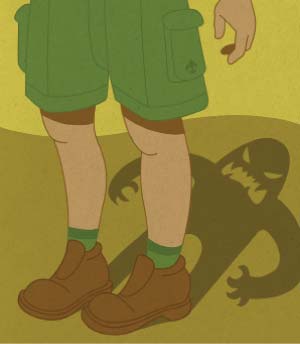
Jekyll and Hyde Jr.
Why kids get angry and what adults can do about it.
Illustration by Thomas Fuchs
The scene had been repeated a hundred times on Troop 514’s camp-outs. The Scouts lined up at one end of the campsite and walked slowly toward the distant tree line, picking up tent pegs, trash, and anything else they had dropped over the weekend.
 Then the unexpected happened. A Scout stepped right over a candy wrapper in his path. His mother, an assistant Scoutmaster, called him out, and the Scout responded with a shocking string of abuse that ended with the words “I hate you!”
Then the unexpected happened. A Scout stepped right over a candy wrapper in his path. His mother, an assistant Scoutmaster, called him out, and the Scout responded with a shocking string of abuse that ended with the words “I hate you!”
Scenes like that become more frequent once a boy enters puberty.
A polite and loving Cub Scout can turn into “a sullen, withdrawn, chip-on-the-shoulder, fire-breathing dragon at the age of 14,” in the words of psychologist David Walsh.
The reason, Walsh explains, lies in the relationship between two key parts of the brain, just one of which is fully functional at that age.
The Engine and the Brakes
The functional part is the amygdala, an almond-shaped structure that serves as the brain’s alarm center where fear, anger, and arousal begin. The amygdala is loaded with receptors for the hormone testosterone that surges through an adolescent boy’s body as much as seven times a day. “As the testosterone starts to flow, it floods into the amygdala, which lights up like the Fourth of July,” Walsh says.
Those impulses head off to the prefrontal cortex (PFC), which manages them and weighs the consequences of potential actions. Unfortunately, the PFC is still under construction in the teen years and remains so until the early 20s.
“That’s why boys at that age can be impulsive,” Walsh says. “That’s why they’re risk takers, and that’s why they can be very quick to anger.”
In his book Why Do They Act That Way?, Walsh compares the amygdala and PFC to a car’s engine and brakes. “The brain’s gas pedal is ready for a NASCAR-paced adulthood,” he writes. “But because the PFC is not up to snuff, the brain’s got the brakes of a Model T.”
Explanation Is Not an Excuse
So does that mean adults should put up with tantrums throughout the teen years? Not at all, Walsh says. “Explanation is not the same word as excuse. Kids get better at this by us helping them get better. One of our jobs as Scout leaders is to serve as the surrogate prefrontal cortex.”
Walsh suggests four things adults can do to help kids manage their emotions. First, focus on the behavior, not on the individual. “Instead of saying, “You were really rude,” say something like, “I’m angry that you walked away while I was trying to talk to you.”
Second, avoid escalating the situation. Teens’ brains are built for escalation, and raised voices only worsen their reaction.
Third, says Walsh, set clear expectations and let the teen know what the consequences will be if he doesn’t meet those expectations. Then, follow through. “Make sure the key words are ‘You chose,’ as in ‘You knew what the expectation was, and you knew what the consequence would be, so you chose this consequence.’”
Fourth, communicate clearly with words and don’t rely on body language. Why? Walsh explains that adults process nonverbal cues in the prefrontal cortex. Adolescents, on the other hand, use a different part of the brain: the amygdala, the very place where the trouble first begins.
To learn more about David Walsh’s work, see his book Why Do They Act That Way? or visit drdavidwalsh.com.